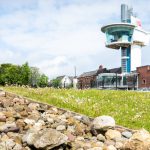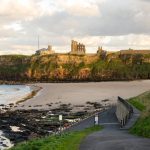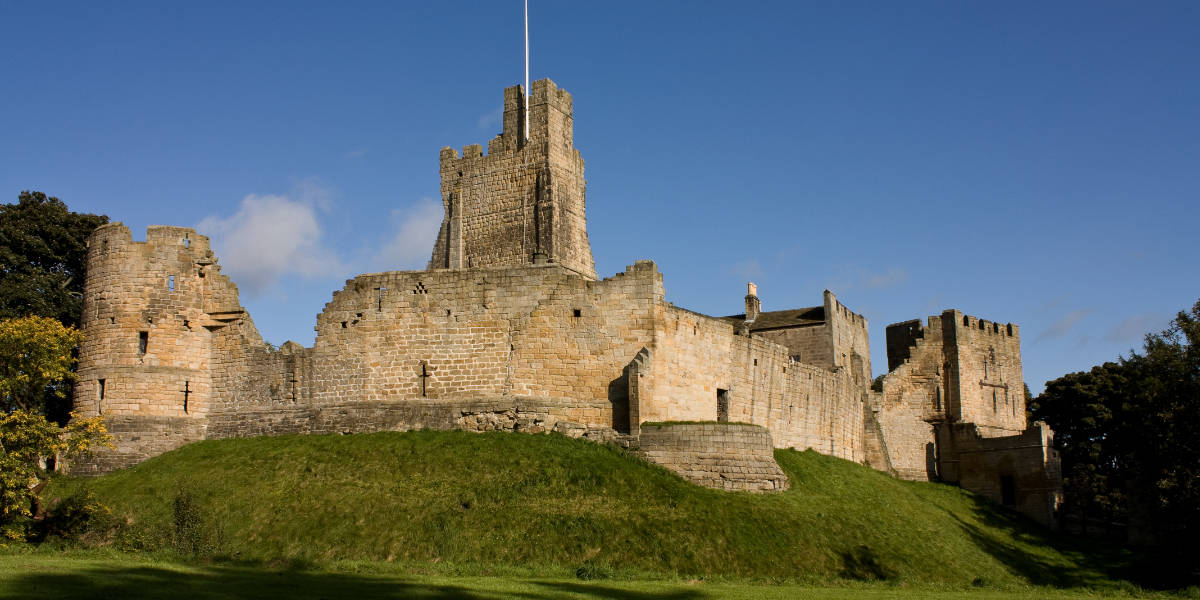
Famously home to a Norman-era castle, Prudhoe is a northern tourist town just to the south of the River Tyne.
Part of the ancient kingdom of Northumberland, Prudhoe was one of those towns in the north that William the Conqueror had trouble subduing. As a result, they received a castle and a Norman ruler who aimed to keep the population under control. To this day, the people of Prudhoe are fierce when they need to be, strong when they have to be, and welcoming to the tourists that come to poke around the castle.
Here is everything we could dig up about this inspirational northern town. We’ll start from the beginning, just as soon as we work out where the beginning is.
The Early Days of Prudhoe
Prudhoe is about 11 miles from Newcastle city centre, which explains why it makes a great commuter town nowadays. However, this land has seen occupation since the early days of human history. The real history starts all the way back in the Bronze Age. Early human history became apparent when a local farmer unearthed a Bronze Age Sepulchre while tilling the soil in 1847. After this, archaeologists found flint knives, axe heads, charcoal, and even evidence of an early burial under the castle.
Beyond the early Bronze Age humans, the Romans had hundreds of garrisons this far north. Obviously, they needed the soldiers to build the wall a little farther up. However, they also needed the soldiers to fight their way north into Scotland. Prudhoe appears in documentation from this time under many different versions of the same name. Historians argue over whether the situation of the town overseeing the river means it was in a ‘proud’ position, and that it was on a ridge. The other interpretation is that the land belonged to an early settler named Prudda. Either way, Prudhoe has evolved over the years.
Northumberland has a rich Roman history which involves road building, garrisons, and walls. The Romans arrived in 43AD, took a generation to reach the north of England, and stayed for about three hundred years. When they left, they took a huge volume of the population with them. A few would have stayed behind, becoming used to the weather and probably starting families of their own. The Romans would build first in wood and then in stone, so many of the wooden garrisons are no longer around. If you want to see and explore a Roman fort nearby, the best one to view is Housesteads, although you are not far from the wall.
Medieval History of the Area
Prudhoe pretty much fell off the map until the Normans arrived. More likely, nobody wrote anything down about it and there wasn’t a church, so we have no records. William the conqueror sent his relative up here to man the fort he built to take control of the town. Robert de Umfraville, or Robert with the Beard, was the ruler of Redesdale. It was rather William’s son – Henry I – who made Prudhoe a barony. The original castle was probably an old motte and bailey style. Records from nearby Alnwick castle describe this as the Bailliewick of Prudhoe Castle.
Robert’s descendant Odinel de Umfraville took down the wooden castle and rebuilt it in stone. He built it 150 ft up on the ridge with a gateway to the south. Odinel had a horrible time trying to build it though. The feudal lords of that period could call on the townsfolk for help, but Prudhoe still wasn’t very large. The baron sent for the residents of Wylam instead. They refused his call since Wylam was the property of the monks of St Oswin’s monastery. The baron was so angry that legend says he went to the monastery intent on stealing their cattle to teach them a lesson. When he got there, the St Oswin himself vanished all the cattle so he couldn’t find them, and he went back home to build his castle without cattle, help, or Wylam.
He said some pretty weird stuff a few years later when William the Lionheart, the Scottish king, invaded the north of England. Odinel said he would be accursed and excommunicated before the Scottish king took his ‘pride and joy’ – the castle. Luckily for him, he didn’t get excommunicated because the Scots never took Prudhoe’s castle. The king of the Scots retreated to Carlisle and called on Odinell to surrender, but he did not. Instead, he fled to the Archbishop of York and sought sanctuary. While this wonderfully brave fellow deserted his own people, the Scots attacked again and were thwarted. Someone obviously had a really good garrison commander.
Around 1213-1216 the First Barons War raged across England. The Baron of Prudhoe Castle, who by this time was Richard again, decided to take arms against the evil king John. John was the king who granted the Magna Carta, but also the evil king from the Robinhood stories. He collected excessive taxes from the people only to splurge it on fine wine and rich meats while the people starved. Realistically, it was only a matter of time before people got sick of him. The barons rose up and fought him, and he died anyway in 1215. The king stripped the Umfravilles of their beloved castle before he died and gave it to Henry de Baliol, who was one of his favourites and held extensive lands up and down England. When John died and Henry III came to the throne, he restored the Umfraville lands and rights. In thankfulness, Richard gave the Hexham monks a homestead and lands. These fell around where the Dr Syntax pub is nowadays.
The last Umfraville died in the late 1300s with the lands falling into the hands of the Percy family. The Percys were a reputable family of great renown. They were as powerful as the great earls of the south. They held the castle at Prudhoe, but also the castles at Alnwick, Warkworth, and Bamburgh. Percy Lord Hotspur was the first Lord of Northumberland, appointed in 1377 at Richard II’s coronation.
Next came the ‘incident’ in 1405 when one of Hotspur’s descendants rebelled against King Henry IV. The castle was taken without a fight when the king marched on it with a whole army.
It gets worse because the monarchy gave the Percy family back the castle only for him to become part of Guy Fawkes’ gunpowder plot. It’s all this stuff that makes the Percy family notorious throughout English history. They repeatedly had everything and constantly threw it away.
By 1622 Prudhoe had 22 tenements, three corn fields, and a fourth field for communal growth. By then the castle was nearly in ruins. Let’s leave off there and pick up the history in the industrial period.
Fun Facts About Prudhoe
During this piece of our tour, we like to dig up some facts and trivia about the town. This is where you find out how remarkable Prudhoe really is. Here is what we could find out about this hardy northern town:
- A 1307 town inventory records an admirable 120 acres of fields, 16 cottages, a pool, a fishery, and two watermills. The pool seems out of place.
- In 1995 the kids at Ovingham Middle School found a cannonball on the grounds which threw everyone through a loop. The cannonball dated to the 17th While there is little evidence to suggest that there was civil war activity in Prudhoe, this cannonball suggested otherwise. There were soldiers at both Corbridge and Hexham, so now historians think the civil war did pass through this way.
- A 1989 letter from the custodian of the castle for two years declared that it was an overgrown brambly wilderness. It also mysteriously mentioned that neither the custodian or her mother would go near the conservatory out of fear.
- Legend says that there is a secret tunnel somewhere under the castle that runs for three miles. Knowing Umfravile’s weird attachment to it, it might well be right. Nobody has found archaeological evidence of this, but that doesn’t mean to say it’s not there.
- Four couples once lived in Prudhoe castle at the same time, with one of the ladies admitting that she knew of the Grey Lady – the ghost which haunts Prudhoe castle. She said she never felt uncomfortable in the castle unless she was alone in the East Tower when she could hear the chanting coming from the empty chapel at night.
On that spooky note, Let’s take another look at this spooky castle.
Industrial Era Northumberland
Over time, residents have experienced a ghostly white horse, someone bouncing a ball outside, water being hurled at the bedroom door only for there to be no water, the whole house shaking as if it were exploding, a solid oak table overturning on its own, facial paralysis, unseen burglars, and one resident who dressed in a black cloak and liked to pretend he was Dracula. Rumour has it he killed himself jumping off the castle walls. So yeah, if you like a good haunt, you will love Prudhoe castle.
Horrifyingly, Prudhoe had its own camp for ‘feeble-minded and mentally defective children.’ The Prudhoe Hall Colony opened in 1914, in the hall that previously belonged to the Liddell family and was built in 1870. It was set up by the Joint Poor-Law Committee, which was headed by a reverend and had a bishop on the committee. After WWI, the poor colony for children expanded to include enough housing for 400 ‘patients’.
In 1930, the colony expanded to hold 700 patients, except by now they called them ‘inmates’. The NHS took over the site in 1948, increasing capacity to 1,500 beds. There were 400 children at that time. Disgustingly the hall and gardens have listed building status. These places should be burned to the ground. Instead, there are plans to redevelop the site. Nothing you ever build on it won’t be cursed. This particular building fell out of use early. They were still building these asylums until the 1980s. People still perform lobotomies, with one even televised in the early 00s.
There were coal haulage railways in the area, which suggests mining nearby. The Wylam wooden wagonway opened in 1748 and ran from Wylam Colliery to Lemington. Parts of these tracks became assimilated into the Wylam railway in 1875.
There was a Prudhoe cycling club in 1900. Here is a lovely photo of them.
The Modern Day Town of Prudhoe
A bunch of Fusiliers stayed here in 1914. The grounds they set up their drill hall on were meant to be redeveloped in 2018 but the owner of the land got jail time, instead. Then in the Cold War, a Royal Observer Corps opened an underground monitoring post… but there were definitely no secret tunnels under Prudhoe. The train station opened in 1838.
The last few years have seen a slow growth of the town. The population stands at just over 11,000. Whatever you think about the ghosts, whatever you think about Prudhoe, remember that these were people who refused to surrender to William the conqueror, and then refused to help their new lord build his castle. That’s pretty cool when you think about it. Never back down.
Famous People from Prudhoe
Every town in England has at least one celebrity, no matter how obscure and unknown. Here are the famous people from Prudhoe that you may cross paths with, while you are visiting:
- The Percy family are as notable as the Umfraville family here.
- The guy who played Clarence in It’s a Wonderful Life, Henry Travers lived here.
- Footballing brothers Jak Alnwick and Ben Alnwick grew up here. One plays for St. Mirren and the other for the Bolton Wanderers, that’s a talented footballing family.
- Steven Savile, the Sci-Fi novelist, lived here.
- Gaz Beadle from Geordie Shore lived here for a few years.
Most of the celebs from here are past tense. Unless you want to run into one of the guys from Geordie Shore, you probably won’t meet anyone famous.
The Best Attractions in Prudhoe
This is the section we all look forward to – the section that tells you where the best things to see and do in Prudhoe are.
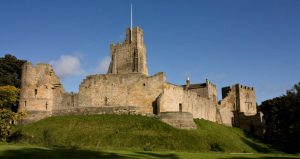
Image: Crepesoles/Shutterstock.com
The most recognisable local landmark is Prudhoe Castle which dates back to early Norman times. It is now administered by English Heritage and it is well worth blocking off a few hours to experience it properly. The grounds are exquisite and there is also a fine Georgian mansion to explore. Tickets can be bought online or you can pay on the day. It is usually cheaper to book in advance. There are places to buy food on-site, or you can bring a picnic which is a great choice on a sunny day.
Listed Buildings
There are twelve listed buildings within the town’s postcode (including the Castle). All of which are fairly easy to find. The most unusual of these is the railway station footbridge picture below…
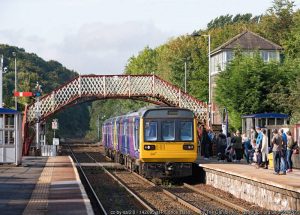
You can check out the full list here
Outdoor attractions
There are two main outdoor attractions in Prudhoe and they are both parks. The Prudhoe Riverside Park is on the River Tyne, just on the other side of the castle. The Eastwoods Park is across town. The Riverside Park has 200 acres of quiet meadows, chalky stretches, and woodlands along the banks of the Tyne. There are four miles of land here, where you can enjoy long walks and picturesque scenery.
The Eastwoods Park used to be known as West Wylam Welfare. It has a lovely swing park for the little ones, football pitches for the larger ones, and a cricket strip complete with pavilions. The park is going through some improvements at the moment, but it was already kind of awesome, to begin with. While the Riverside is calm and tranquil, this park is always filled with the laughter of little children and the frustrated shouts of teens when the match isn’t going their way.
Sports and teams
Prudhoe has a youth football club but no adult team. However, it does have a couple of golf clubs in the vicinity. Prudhoe Golf Club was founded late in comparison to nearby towns. It opened in 1930. There is a country club onsite as well, so you can enjoy the full experience. You will find it in Eastwood Park. If you want more, you can try Tyneside golf club, which is a slightly bigger club. By comparison, Tyneside is the oldest golf club in the entire northeast of England.
Recreation in Prudhoe
There is a Water world in Prudhoe which contains a pool and other recreational activities and equipment. Part of the complex is a gym and there is soft play in the building, too. It’s all run by Active Northumberland.
Prudhoe also has its own cinema. The Fuse community cinema has a little tuck shop and is community run. Reviewers say it is a clean little space, great for student shows and mainstream pictures. Check what’s on if you are spending time in town or need a cosy date location.
Prudhoe even has its very own snooker club. It might not be the largest of towns, but the residents sure do know how to keep themselves entertained.
Shopping and retail
The best shops in Prudhoe are all around the town centre. If you want big shopping centres, take the 11-mile trip to the city.
Where to Eat and Drink in Prudhoe?
If you want a pie and a pint, the Falcon is a good Prudhoe pub with plenty of British fare. They also do burgers and a Sunday carvery. If you want pizza, head to Wylam to the Wood Oven, which is just as rustic and delicious as it sounds. If you would like something classier for a date or a treat, the Gloria Italian restaurant might fit the bill. Dr Syntax is a popular pub, or you can get a cocktail in nearby Wylam at the Ship Inn.
Other Nearby Notable Attractions
The nearest museum is the Wylam railway museum. This is also a birthplace museum there for George Stephenson, one of the railway’s early pioneers. In fact, the museum opened to celebrate its 200th anniversary back in 1981. Stephenson is renowned as the father of railways. He was a civil engineer and a railway engineer who developed the traditional standard gauge railway line which we still use throughout most countries in the world to this day. It’s well worth a visit.
Derwentcote Steel Furnace
Derwentcote Steel Furnace is also well worth a visit if you have the car with you anyway. It is located in nearby Rowlands Gill which is around 7 miles away. It dates back to 1730 and although there is no access to the interior buildings it still makes for an interesting visit. There are occasional guided tours too. The list of dates is available here.
Once you get through these attractions, you will be interested to know there are a few more in nearby towns. Especially if you are using Prudhoe as a staycation base.
- Visit the Morpeth Markets, once the largest market town in Northumberland.
- Learn about the north’s long history of coal mining in Cramlington.
- Visit the coastline of nearby Blythe and walk the shores.
- See the coal mines in Ashington, the world’s biggest-ever mining village in the 19th
- Visit Hadrian’s wall near Hexham to see some history.
- Swap the River Tyne for the River Tweed in Berwick-upon-Tweed.
- Let’s not forget the biggest shopping attraction for miles around – Newcastle upon Tyne.
And if you see all this and you are still hungry for more? Go and explore Tyne & Wear.
How to Get to Prudhoe?
Lastly, we ought to tell you how to get there or there will be lots of lost visitors driving around the north in desperation.
By Road
Take the A69 out of Newcastle and turn south after you pass through Heddon-on-the-wall.
By Rail
Prudhoe station is on the northern line. Go by train and get an Instagram selfie on the foot bridge.
By Air
Your nearest airport is Newcastle International.
By Sea
Your nearest port is Tynemouth.
Got Five More Minutes?
If you loved this travel guide as much as we enjoyed writing it, then you can find a whole bunch more just like it on the Five Minutes Spare website. If you found it interesting then join us by signing up leave us a like on Facebook.

